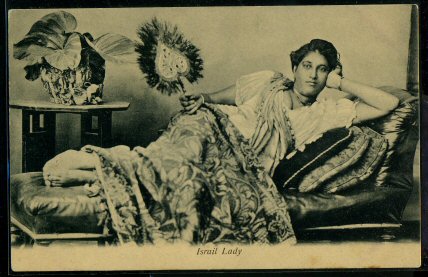
This is a classic example of the Jewish Woman in India 1910.

Indian Jewish Communities India had through the 21st century the largest number of Jews of any country east of Iran. Their population peaked in 1950 at around 30,000–35,000, after which immigration to Israel and other places reduced their number to around 4,000–6,000 in the early 2000s, more if the so-called B’nai Menashe and B’nai Ephraim are counted. There have been three major distinct Jewish communities in India. The oldest group is found in and around Kochi in the southwestern state of Kerala, who today number fewer than 50. Perhaps 5,000 Cochinim, as they are called in Hebrew, live in Israel. The largest group is known as *Bene Israel and is found chiefly in and around Mumbai (previously Bombay), with active communities in Pune, also in Maharashtra state, in Ahmedabad in Gujerat state, and in New Delhi. All told, there are 4,000–5,000 Bene Israel in India and 40,000–50,000 in Israel, where they make up a significant ethnic group (edah in Hebrew) known as Hodi’im (“Indians”). The most recently arrived group are known in India as Baghdadis, Middle Eastern Jews, Arabic speakers mostly, who migrated to India during the late 18th century, about the same time as the British arrived, and who settled in India’s port cities, especially Mumbai and Kolakata. Numbering about 5,000 at their peak, they declined to around 100, most of whom are elderly. The Baghdadis played a significant role in the development of British India’s ports. Beginning as jewelers and in the opium trade, Baghdadi entrepreneurs soon moved into textiles and shipping in Mumbai, and real estate, jute, manufacturing, and tobacco in Kolakata. Replicating Jewish experience in America, humble boxwallahs (door-to-door salesmen) settled down and became department store magnates. Of the three groups, only the Bene Israel remains viable as a community. While most Bene Israel live in Mumbai, the nearby Konkan coast is their spiritual home. Bene Israel trace themselves back to seven couples from Israel who survived a shipwreck off Navgaon, in the unknown, distant past. Somehow they clung to vestigial Judaic observances despite centuries of isolation. Their tenacity in maintaining the Sabbath, ritual circumcision, Jewish dietary codes, and the Hebrew Shema – the affirmation “Hear O Israel! The Lord is our God, the Lord is One” – set the stage for their unlikely transformation from an anonymous oil-pressing caste in the remote Konkan into modern, urban members of the world Jewish community. This evolution occurred over 200 years ago, beginning in the middle of the 18th century. A Kochi merchant heard rumors of a Konkani caste that rested on Saturday and circumcised their sons on the eighth day, so David Rahabi visited them. After spending some time with the community, examining their dietary habits as well as eccentric (by Hindu standards) religious observances, he concluded that they were lost Jews. He took three of them back to Kochi where he educated them in Hebrew and the rudiments of Judaism and sent them back with the title of kazi, religious leader. This began a longstanding relationship between Bene Israel and Kochi Jews; as Bene Israel prospered, they hired Kochi Jews to be their cantors, teachers, ritual slaughterers, and scribes. Bene Israel recall these events as their “first awakening.” [Encyclopaedia Judaica]